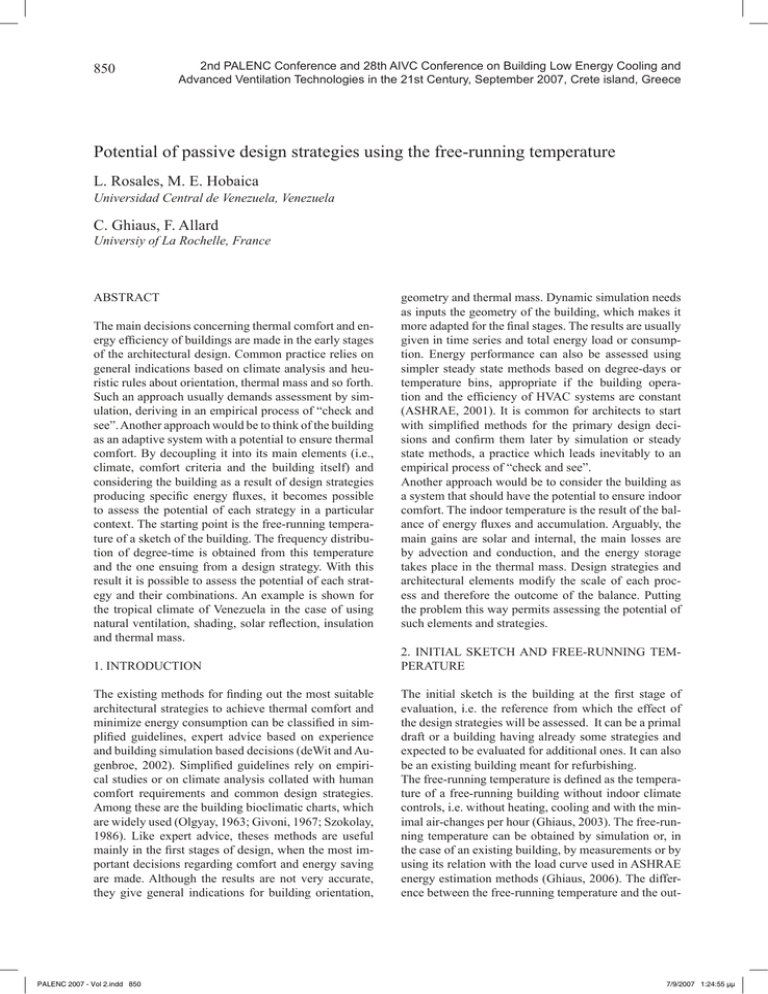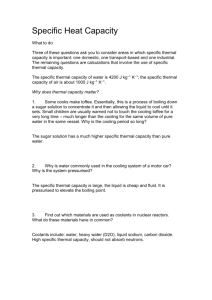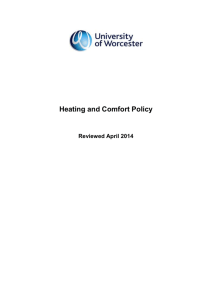Potential of passive design strategies using the free
advertisement

850 2nd PALENC Conference and 28th AIVC Conference on Building Low Energy Cooling and Advanced Ventilation Technologies in the 21st Century, September 2007, Crete island, Greece Potential of passive design strategies using the free-running temperature L. Rosales, M. E. Hobaica Universidad Central de Venezuela, Venezuela C. Ghiaus, F. Allard Universiy of La Rochelle, France ABSTRACT The main decisions concerning thermal comfort and energy efficiency of buildings are made in the early stages of the architectural design. Common practice relies on general indications based on climate analysis and heuristic rules about orientation, thermal mass and so forth. Such an approach usually demands assessment by simulation, deriving in an empirical process of “check and see”. Another approach would be to think of the building as an adaptive system with a potential to ensure thermal comfort. By decoupling it into its main elements (i.e., climate, comfort criteria and the building itself) and considering the building as a result of design strategies producing specific energy fluxes, it becomes possible to assess the potential of each strategy in a particular context. The starting point is the free-running temperature of a sketch of the building. The frequency distribution of degree-time is obtained from this temperature and the one ensuing from a design strategy. With this result it is possible to assess the potential of each strategy and their combinations. An example is shown for the tropical climate of Venezuela in the case of using natural ventilation, shading, solar reflection, insulation and thermal mass. geometry and thermal mass. Dynamic simulation needs as inputs the geometry of the building, which makes it more adapted for the final stages. The results are usually given in time series and total energy load or consumption. Energy performance can also be assessed using simpler steady state methods based on degree-days or temperature bins, appropriate if the building operation and the efficiency of HVAC systems are constant (ASHRAE, 2001). It is common for architects to start with simplified methods for the primary design decisions and confirm them later by simulation or steady state methods, a practice which leads inevitably to an empirical process of “check and see”. Another approach would be to consider the building as a system that should have the potential to ensure indoor comfort. The indoor temperature is the result of the balance of energy fluxes and accumulation. Arguably, the main gains are solar and internal, the main losses are by advection and conduction, and the energy storage takes place in the thermal mass. Design strategies and architectural elements modify the scale of each process and therefore the outcome of the balance. Putting the problem this way permits assessing the potential of such elements and strategies. 1. INTRODUCTION 2. INITIAL SKETCH AND FREE-RUNNING TEMPERATURE The existing methods for finding out the most suitable architectural strategies to achieve thermal comfort and minimize energy consumption can be classified in simplified guidelines, expert advice based on experience and building simulation based decisions (deWit and Augenbroe, 2002). Simplified guidelines rely on empirical studies or on climate analysis collated with human comfort requirements and common design strategies. Among these are the building bioclimatic charts, which are widely used (Olgyay, 1963; Givoni, 1967; Szokolay, 1986). Like expert advice, theses methods are useful mainly in the first stages of design, when the most important decisions regarding comfort and energy saving are made. Although the results are not very accurate, they give general indications for building orientation, The initial sketch is the building at the first stage of evaluation, i.e. the reference from which the effect of the design strategies will be assessed. It can be a primal draft or a building having already some strategies and expected to be evaluated for additional ones. It can also be an existing building meant for refurbishing. The free-running temperature is defined as the temperature of a free-running building without indoor climate controls, i.e. without heating, cooling and with the minimal air-changes per hour (Ghiaus, 2003). The free-running temperature can be obtained by simulation or, in the case of an existing building, by measurements or by using its relation with the load curve used in ASHRAE energy estimation methods (Ghiaus, 2006). The difference between the free-running temperature and the out- PALENC 2007 - Vol 2.indd 850 7/9/2007 1:24:55 µµ 2nd PALENC Conference and 28th AIVC Conference on Building Low Energy Cooling and Advanced Ventilation Technologies in the 21st Century, September 2007, Crete island, Greece door temperature may be considered independent from outdoor temperature, since it is basically the ratio between the heat gains and the overall heat transfer coefficient. Within intervals with no major changes in solar angles, the dispersion due to random disturbances like occupancy, ventilation and solar gains can be set aside, especially when occupancy is constant and the building is airtight. With these assumptions, it may be accepted that, for a given month of the year, the difference between the free-running temperature and the outdoor temperature is a function of the hour of the day (Figure 1). As a consequence, the free-running temperature can be used instead of balance point temperature in degreedays or bin methods (Ghiaus and Allard, 2006). 851 ited by a lower acceptable temperature, Tcl, and an upper acceptable temperature, Tcu. 4. DOMAINS Setting up a passive design strategy shifts the free-running temperature, Tfr, to a new indoor temperature, Tst. At a specific hour, this shift can be negative (Tst < Tfr) or positive (Tst > Tfr). In the first case the strategy cools down the building (passive cooling) and in the second, it heats it up (passive heating). Figure 2 shows the domains for mechanical cooling, comfort and heating when Tst < Tfr. These domains can be expressed by binary value functions, as follows. Before setting up the passive strategy, the condition for mechanical cooling was: (1) For this condition, the degree-hour for mechanical cooling is: (2) In the case of a passive design strategy, the condition for mechanical cooling becomes: (3) For this new condition, the degree-hour needed to be balanced by mechanical cooling is: Figure 1. Visualization of the difference between indoor and outdoor temperature in a free-running building. 3. COMFORT CRITERIA ASHRAE 55 and ISO 7730 standards specify the temperature range for which people having low activity feel the environment thermally adequate. It is accepted that these standards perform properly for moderate environments and HVAC controlled buildings. However field studies have shown that people adapt to the environment and that comfort in naturally ventilated buildings has larger seasonal ranges. As a result, linear correlations linking an optimal comfort temperature to mean outdoor temperature have been proposed (de Dear et al., 1997; Brager and de Dear, 1998; Nicol and Humphreys, 2002). Figure 2 shows a correlation proposed by Brager and de Dear (1998). A neutral zone is defined by a range which extends both sides of the optimum temperature, corresponding to 90% acceptability. This zone is delim- PALENC 2007 - Vol 2.indd 851 (4) The difference between Eqs. (2) and (4) gives the degree-hour that the strategy saves for mechanical cooling. In contrast, the strategy can be inappropriate for low outdoor temperatures, when heating may become necessary. It follows that it would be suitable to control it, in order to move back toward the free-running building condition. The condition for which the free-running building must be heated is: (5) And the degree-hour for heating the free-running building is: (6) 7/9/2007 1:24:56 µµ 852 2nd PALENC Conference and 28th AIVC Conference on Building Low Energy Cooling and Advanced Ventilation Technologies in the 21st Century, September 2007, Crete island, Greece The difference between Eqs. (8) and (6) gives the heating saved by controlling the passive strategy. This control may be achieved by behavioural or technological means and depends on the possibilities of the strategy. For an extended number of days (e.g., 365), the sum of the degree-hour given by Eqs. (2), (4), (6) and (8) in bins of outdoor temperature gives the degree-hour distribution as a function of outdoor temperature. Putted in a common form, this would be: Figure 2. Domains for mechanical cooling, comfort and heating for the free-running building, before and after the use of a passive design strategy (Tst < Tfr). The condition for which the building after using the passive strategy must be heated is: (9) where DH ( j ): is the total degree-hour for bin j of outdoor temperature ΔT ( i, j ): is the temperature difference for day i and bin j δ: is the condition being evaluated by Eqs. (2), (4), (6) and (8) The integral of the degree-hour distributions obtained for each condition by applying Eq. (9) gives the total degree-hours for the hour being analyzed and through the time interval. An analogous reasoning can be made when the strategy heats up the building (Tst > Tfr). 5. EXAMPLE And the degree-hour for heating is: (7) (8) To illustrate the method, a simple house was simulated. Two different locations were chosen: Caracas and Maracaibo, which are the most populated cities of Venezuela. Both cities have the same latitude (10.5º N) and Table 1. Annual degree-hours at 3 h, 9 h, 15 h and 21 h for two locations of Venezuela of same latitude (10.5ºN) and different altitudes: Caracas: 950 m ; Maracaibo: 60 m. Free-running Caracas 3h 9h 15 h 21 h Maracaibo 3h 9h 15 h 21 h PALENC 2007 - Vol 2.indd 852 Shading Natural ventilation Thermal mass Solar reflection Insulation Cooling 0 0 0 0 0 7 Heating -201 -560 -932 -82 -482 0 Cooling 1 0 0 0 0 420 Heating -57 -233 -315 -40 -180 0 Cooling 1021 51 161 0 104 1399 Heating 0 -3 -9 -8 0 0 Cooling 0 0 0 0 0 19 Heating -55 -240 -399 -26 -186 0 Cooling 32 0 0 111 1 1112 Heating 0 0 -3 0 0 0 Cooling 502 132 161 381 210 2087 Heating 0 0 -1 0 0 0 Cooling 2223 1003 1274 453 1210 2590 Heating 0 0 0 0 0 0 Cooling 152 12 3 373 21 1254 Heating 0 0 0 0 0 0 7/9/2007 1:24:56 µµ 2nd PALENC Conference and 28th AIVC Conference on Building Low Energy Cooling and Advanced Ventilation Technologies in the 21st Century, September 2007, Crete island, Greece their seasonal variations are small. However, Caracas altitude is 950 m and has a warm humid/moderate climate (average temperature 22.5 ºC) while Maracaibo altitude is 60 m and has a warm-hot humid climate (average temperature 27.5 ºC). The house was conceived concerning basic geometry, considering that walls and roof are conductive with dark finishes and that the windows are single glazed and are closed (i.e., the house 853 is tight). The internal loads are constant and consist of home equipment and 5 occupants. It is intended to analyze the potential of five design strategies in broad terms: shading, natural ventilation, thermal mass, insulation and solar reflection. The hypotheses were: a) the best shading corresponds to a building receiving only diffuse solar radiation, b) the best possible ventilation corresponds to a relatively high ventilation rate of 50 Figure 3. Degree-hour distribution at 15 h and 21 h for (a) Caracas and (b) Maracaibo. PALENC 2007 - Vol 2.indd 853 7/9/2007 1:24:57 µµ 854 2nd PALENC Conference and 28th AIVC Conference on Building Low Energy Cooling and Advanced Ventilation Technologies in the 21st Century, September 2007, Crete island, Greece ach, c) the higher thermal mass consists of walls and roof having a 10 h time lag, d) the optimal solar reflection consists of highly reflective walls, roof and windows, and e) the best insulation corresponds to non-conductive light-weigh walls and roof. It is important to note that these hypotheses can be argued or that the evaluation can target other types of strategies concerning specific elements, e.g., broad or particularly orientated lees. Figure 3 shows the degree-hour distributions at 15 h and 21 h in both cities throughout 365 days for the free-running building and for the same building having settled the design strategies separately. Table 1 shows the results of integrating these curves along with those obtained for 3 h and 9 h. The results give a primary indication about which design strategies may have the priority for achieving comfort and minimizing energy consumption. For example, in Caracas, cooling can be completely achieved at 15 h by maximizing thermal mass, with the benefit that it brings low heating requirements at 21 and 3 h. If maximizing thermal mass is not practical, optimizing shading or natural ventilation appear to be good solutions, particularly if behavioural or technological adaptation is foreseen. As observed, at 15 h, natural ventilation fully covers the cooling requirements for at least half a year. It has also the advantage that it is easy to adjust at night by simply closing windows. On the other hand, in Maracaibo, there is no need for heating, no matter the strategy used. Maximizing thermal mass appears to produce lower cooling requirements at 15 h, but they become higher at 9 h, 21 h and 3 h. Shading and natural ventilation emerge as better solutions, as their potential for cooling drops only in the afternoon. It also comes out that maximizing insulation can be very unfavourable in both locations. However, it is well known that insulation is a good strategy in warm sunny climates if applied partially or in combination with other strategies. Indeed, the potential of any partial application of theses strategies or any combination of them can be assessed using the same approach. 6. CONCLUSIONS Assessing the potential of design strategies depends on building thermal behaviour, comfort criteria and climate. In the early stages of design, the interest consists in deciding on correct solutions founded on broad data. Usually this is done by simplified guidelines, which give general indications for basic strategies such as orientation, ventilation or thermal mass. A more specific approach is to use the concept of free-running temperature, defined as the temperature of a free-running building without indoor climate controls. If air-change rate PALENC 2007 - Vol 2.indd 854 is minimal and heat gains are moderately stable, the difference between indoor and outdoor temperature can be considered independent from outdoor temperature. It follows that having an initial draft of the building any further change on its thermal characteristics will produce at a same hour a constant shift of the indoor temperature. The potential of any design strategy can then be assed by the frequency distribution of the differences between the indoor temperature and the comfort limits as a function of outdoor temperature. This method gives much more information than the common simplified methods. The procedure can be used at any stage of the design process with the condition that at least a primary sketch of the building is available. It can also be used for assessing the potential of specific architectural elements or combinations of design strategies. ACKNOWLEDGMENT This study was supported by France-Venezuela Programme Ecos-Nord (Project Ispaven-9269). REFERENCES ASHRAE (2001). Energy Estimating and Modeling Methods. ASHRAE Fundamentals. Brager, G., de Dear, R. (1998). Thermal adaptation in the built environment: a literature review. Energy and Buildings 27: 83–96. de Dear, R., Brager, G., Cooper, D. (1997). Developing an adaptive model of thermal comfort and preference, final report ASHRAE RP-884, American Society of Heating, Refrigerating and Air Conditioning Engineers, Inc., and Macquarie Research, Ltd. deWit, S., Augenbroe, G. (2002). Analysis of uncertainty in building design evaluations and its implication. Energy and Buildings 34: 951–958. Ghiaus, C. (2003). Free-running building temperature and HVAC climatic suitability. Energy and Buildings 35: 405–411. Ghiaus, C. (2006). Equivalence between the load curve and the free-running temperature in energy estimating methods. Energy and Buildings 38: 429-435. Ghiaus, C., Allard, F. (2006). Potential for free-cooling by ventilation. Solar Energy 80: 402-413. Givoni, B. (1967). Man, climate and architecture. London: Applied Science Publishers Ltd. Nicol, F., Humphreys, M.A. (2002). Adaptive thermal comfort and sustainable thermal standards for buildings. Energy and Buildings 34: 563–572. Olgyay, V. (1963). Design with climate, bioclimatic approach and architectural regionalism. Princeton (NJ). Princeton University Press. Szokolay S. (1986). Climate analysis based on psychrometric chart. Ambient Energy 7(4): 71-81. 7/9/2007 1:24:57 µµ


